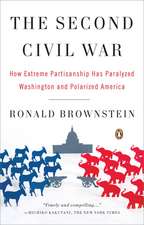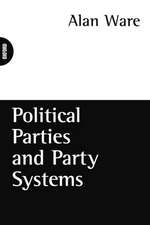When Political Parties Die: A Cross-National Analysis of Disalignment and Realignment
Autor Charles S. Macken Limba Engleză Hardback – 10 aug 2010 – vârsta până la 17 ani
Preț: 368.89 lei
Preț vechi: 504.56 lei
-27% Nou
Puncte Express: 553
Preț estimativ în valută:
70.59€ • 73.90$ • 58.41£
70.59€ • 73.90$ • 58.41£
Carte tipărită la comandă
Livrare economică 05-19 aprilie
Preluare comenzi: 021 569.72.76
Specificații
ISBN-13: 9780313385469
ISBN-10: 0313385467
Pagini: 344
Dimensiuni: 156 x 235 x 28 mm
Greutate: 0.72 kg
Editura: Bloomsbury Publishing
Colecția Praeger
Locul publicării:New York, United States
ISBN-10: 0313385467
Pagini: 344
Dimensiuni: 156 x 235 x 28 mm
Greutate: 0.72 kg
Editura: Bloomsbury Publishing
Colecția Praeger
Locul publicării:New York, United States
Caracteristici
The bibliography contains a reference list of important and pertinent works on party systems, leadership and realignment, as well as on the politics of pre-Civil War America; Britain after World War I, Italy after World War II, and the full scope of Canadian politics
Notă biografică
Charles S. Mack, PhD, is a post-doctoral scholar in politics at the Catholic University of America, Washington, DC.
Cuprins
List of IllustrationsPrefaceChapter One IntroductionParty Disalignment and RealignmentCharacteristics of DisalignmentRealignment TheoryWorking Definitions and VariablesObjectives and HypothesesMethodologyPlan of the BookChapter Two Parties and Party SystemsMajor vs. Minor PartiesThe Party BaseParty LabelsA Definition of Political PartiesParty System Consolidation and InstitutionalizationSocioeconomic Cleavages and Party PreferencesNew Parties and New CleavagesParty DurabilityParty SystemsElectoral SystemsParty TypesPerspectives on LeadershipChapter Three Realignment and DealignmentThe Origins of Realignment TheoryRealignment CriticismsRealignment Resurrected?The Dealignment PerspectivePolitical Change outside the United StatesChapter Four Disalignment and Realignment: A New Theoretical ApproachA Different LensCalculation of Parties' Bases and Medial VotersA Theory of DisalignmentDisalignment and Electoral SystemsA New Theory of RealignmentA Typology of ElectionsIntroduction to the CasesHypothesesChapter Five The Case of the American Whig PartyOrigins and Rise of the WhigsThe 1824 ElectionThe 1828 ElectionParty DevelopmentThe Jackson PresidencyThe Birth of the Whig PartyThe 1836 ElectionThe Frustrations of the 1840 ElectionThe Tyler DisasterThe 1844 ElectionThe Mexican War and the 1848 ElectionTaylor, the West, and PatronageThe Compromise of 1850The 1850 Election and Its AftermathThe 1852 ElectionTemperance, Immigration, and CatholicismThe Kansas-Nebraska Bill and the End of the WhigsThe Know Nothing SurgeThe Whig Rise and FallConclusionsChapter Six The Case of the British Liberal PartyOrigins and Rise of the LiberalsLiberal DoctrinesThe Age of GladstoneGladstone and IrelandThe Prewar YearsThe House of Lords BattleLabor DiscordWomen's SuffrageThe Irish CrisesCoalition and War ManagementThe Expanded ElectorateThe 1918 "Coupon" ElectionThe 1920sLocal ElectionsConclusionsChapter Seven The Case of Canada's Progressive Conservative PartyQuebec and Regionalism in CanadaThe Unassimilated ProvinceWestern ProtestThe Party SystemRegional and Provincial CompetitionElectoral Structure and Serial Party SystemsPan-Canadianism in the Third-Party SystemMulroney and the Meech Lake AccordPreludes to DisasterThe 1993 EarthquakeThe New Protest PartiesContinuity of Change: 1997-2002Renewal of Change: 2004-2008Who Won the Merger?Provincial vs. Federal Party SystemsConclusionsChapter Eight The Case of the Italian Party SystemThe Rise of the Italian StateInfluences on the Party SystemThe Quasi-Stable Party SystemThe Postwar Party System to 1992The Collapse of the First RepublicItaly: Conclusions and OutlookChapter Nine Comparative Analysis of the CasesConditions Necessary for DisalignmentsLeadership FailureIntensity of National Identity Cleavage Issues and PositionsAlienation of the Core BaseAvailability of a Successor Party or PartiesThe Electoral SystemAnalysis of the Cases against the HypothesesChapter Ten Conclusions and Implications for American Politics in the 21st CenturyProtecting the BaseBase Integrity and Party PolarizationThe Obstruction of GovernanceThe Intensity of BeliefThe Cartel PartiesNew Party BarriersThe Reform Party ExperienceClarity of ChoiceThe Italian AnalogyCould Disalignments Recur?Are Disalignments Cyclical?Selected BibliographyIndex


















